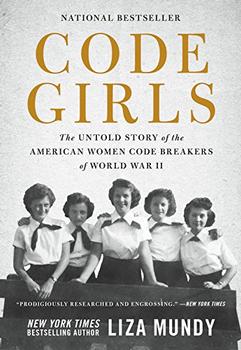Summary | Excerpt | Reading Guide | Discuss | Reviews | Beyond the Book | Read-Alikes | Genres & Themes | Author Bio

The Untold Story of the American Women Code Breakers of World War II
by Liza MundyThis article relates to Code Girls
The National Security Administration (NSA) is the direct descendant of the group established to decode enemy communications during WWII featured in Code Girls. Established by U.S. President Harry Truman in 1952, the NSA is the government agency responsible for signal intelligence — "Intelligence derived from electronic signals and systems used by foreign targets, such as communications systems, radars, and weapons systems."
The once entirely clandestine NSA has started declassifying some of its secret documents and has established three closely affiliated organizations to celebrate its history and to train the next generation of cryptographers.
The first of these, the National Cryptologic School, was founded in 1965 by Deputy Secretary of Defense Cyrus R. Vance, who issued a directive calling for "the establishment of a professional institution to centralize education and training efforts for Department of Defense intelligence activities." Headquartered at Fort Meade, Maryland, the NCS offers numerous courses to NSA employees and other intelligence professionals. Subjects range from foreign language dialect courses to cracking codes specific to a country (Iran, China) or to an activity (drug running); some are simply listed in the catalog as "Title Classified."
Closely tied to the NCS is the Center for Cryptologic History (CCH). According to their website, "The CCH provides a historical and objective account of cryptologic history for the intelligence community, the Department of Defense, other government agencies, academia, and the general public."
Each year the CCH sponsors a public lecture given by a distinguished intelligence historian, as well as a symposium on cryptographic history (such as the 2017 event entitled "Milestones, Memories and Momentum," which looked at milestone events in the world of cryptography, their significance to the security of the United States, and how attendees should use these milestones as inspiration to extend their work into the 21st century). The CCH also publishes an online journal – The Cryptologic Quarterly – about the history of the science as well as (non-classified) breakthroughs in the field.
 Finally, there's the National Cryptographic Museum, opened in 1993 — the first and only public museum devoted to signals intelligence. Open six days a week (excluding holidays), it hosts approximately 50,000 visitors annually. In addition to housing the NSA's archives, it exhibits rare cryptographic artifacts that played important roles in the nation's history. Such treasures include code samples from the Revolutionary War, a Union code book used during the Civil War, and a U.S. Army Signal Flag, one of only two of its kind known to exist. It also contains more modern items, such as a GRAB II Satellite, which was officially used to gather information on solar radiation but was really deployed to intercept signals from Soviet radar equipment. The current gallery of exhibits also includes an 18th century cipher device.
Finally, there's the National Cryptographic Museum, opened in 1993 — the first and only public museum devoted to signals intelligence. Open six days a week (excluding holidays), it hosts approximately 50,000 visitors annually. In addition to housing the NSA's archives, it exhibits rare cryptographic artifacts that played important roles in the nation's history. Such treasures include code samples from the Revolutionary War, a Union code book used during the Civil War, and a U.S. Army Signal Flag, one of only two of its kind known to exist. It also contains more modern items, such as a GRAB II Satellite, which was officially used to gather information on solar radiation but was really deployed to intercept signals from Soviet radar equipment. The current gallery of exhibits also includes an 18th century cipher device.
In addition to the three organizations listed above, the NSA dedicated a memorial in 1996 to its military and civilian cryptographers who were killed in the line of duty. Designed by an NSA employee and displayed at NSA headquarters, the National Cryptographic Memorial is a black granite slab measuring 8 feet tall by 12 feet wide. The names of the 176 individuals — which were classified until the 1990s — are listed under a triangle inscribed with the sentiment "They Served in Silence." The NSA website also lists these names along with links to documents that tell about each individual's life and their service to their country. Only one woman is mentioned – Army Sergeant Amanda N. Pinson, who was killed by a mortar in Iraq in 2006.
Picture of 18th century cryptographic device from Cryptologic Museum
Filed under Society and Politics
![]() This "beyond the book article" relates to Code Girls. It originally ran in October 2017 and has been updated for the
October 2018 paperback edition.
Go to magazine.
This "beyond the book article" relates to Code Girls. It originally ran in October 2017 and has been updated for the
October 2018 paperback edition.
Go to magazine.
Your guide toexceptional books
BookBrowse seeks out and recommends the best in contemporary fiction and nonfiction—books that not only engage and entertain but also deepen our understanding of ourselves and the world around us.